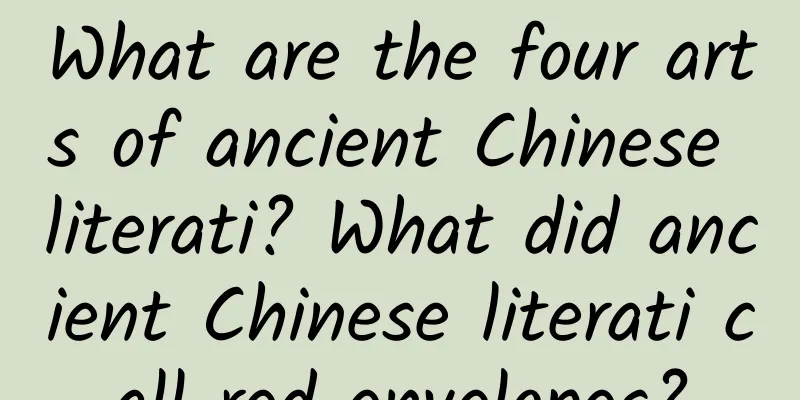What are the four arts of ancient Chinese literati? What did ancient Chinese literati call red envelopes?

|
The lessons and summaries of our predecessors in the pursuit process are actually what we can learn and draw lessons from, so that we, or later generations, can take fewer detours when pursuing, so that we, our descendants, can pursue it earlier. Many literati pursue harmony in life, which actually reflects the harmonious rules of our world. Many disharmony will eventually return to harmony. So what are the four arts of ancient Chinese literati? What did ancient Chinese literati call red envelopes? Let's take a look at the introduction of Encyclopedia Knowledge Network! Contents of this article 1. What are the four arts of ancient Chinese literati? 2. What did ancient Chinese scholars call red envelopes? 3. Ask for the ancient literati's name 1What are the four arts of ancient Chinese literati?The traditional four arts usually refer to the four elegant arts that Chinese literati admire and master, namely, zither, chess, calligraphy, and painting. These four arts are called "the four arts of literati" or "the four arts of scholars". Qin, chess, calligraphy and painting are the spiritual sustenance of the ancients to cultivate their moral character beyond the mundane world. They embody the beauty, nobility and wisdom of the world and pursue the realm of "harmony between man and nature" and "the sameness of heaven and earth". It is the legacy of these literary and artistic forms that allows modern people to touch the profound and broad cultural heritage of ancient China. Qin, chess, calligraphy and painting are also the artistic life content of Chinese literati. As the first of the four arts, the guqin carries many cultural factors, and chess, calligraphy and painting also have their wonderful charm to render Chinese culture. 2What did ancient Chinese scholars call red envelopes?1. Red envelopes, also known as red envelopes and red bags. They first became popular in the Western Han Dynasty and were called "money for winning" and "flower money". This kind of money is not a currency circulating on the market. It is a kind of evil-avoiding item specially cast in the shape of coins for wearing and appreciation. The front of this coin is cast with words and various auspicious words, such as "Long Live the Emperor", "Peace in the World", "Get Rid of Disasters and Eliminate Evil", etc.; the back is cast with various patterns, such as dragons and phoenixes, turtles and snakes, Pisces, swords, stars, etc. This is equivalent to the auspicious gifts given to each other by relatives and friends nowadays, and cannot be used to buy things. 2. The evolution of red envelopes: In the Ming and Qing dynasties, most of the New Year's money was given to children with red strings. After the Republic of China, it evolved into being wrapped in red paper. Now it generally refers to a red paper package containing money; it is used to give gifts during celebrations. In the Cantonese-speaking areas of China, red envelopes are called "lishi", which is a gift made by placing money in a red envelope. 3Ask for ancient literati's nameAncient literati font size: In ancient times, most literati had a name, a courtesy name, and a pseudonym. Generally speaking, it is appropriate to use the courtesy name or courtesy name to honor ancestors; peers should call each other by courtesy names, not by personal names; when addressing younger or inferior people, one should use their personal names when referring to themselves or those who are humble. In addition, the names and courtesy names of ancient people were mostly closely related. |
Recommend
How to draw eyeliner
Eyes are the windows to the soul, and having a pa...
Back pain in late pregnancy
We all know that when pregnant women reach the th...
What to drink if menstruation is not coming out_What soup to drink for delayed menstruation
Many girls will be troubled by irregular menstrua...
[Medical Q&A] How do couples with hepatitis B prepare for pregnancy?
Planner: Chinese Medical Association Reviewer: Zh...
What to do about hair loss in middle-aged women
Women will gradually suffer from hair loss after ...
What is needed for wound healing?
This is the 3661th article of Da Yi Xiao Hu If yo...
Can a woman get pregnant if she has gynecological diseases?
Many women may be affected by gynecological disea...
What causes vulvar itching during early pregnancy?
Vulvar itching is a common gynecological disease....
What are the effects of cervical removal?
Cervicitis and cervical erosion are common diseas...
Highlight the key points! Six common misconceptions about asthma, have you fallen into them? | Things about asthma ②
Recently, with the temperature dropping, coupled ...
White spots on nails = calcium deficiency? Don’t be fooled, the truth is...
"White spots on the nails mean calcium defic...
Excessive androgen in women
Excessive androgen is a manifestation of many wom...
What are the symptoms when you are pregnant?
Every woman has different symptoms when she first...
Does nasal discharge mean ovulation?
Women with normal fertility generally experience ...
What is the difference between oral mucosal fibrosis and oral leukoplakia? How to treat it?
Oral leukoplakia and oral fibrosis are both commo...









